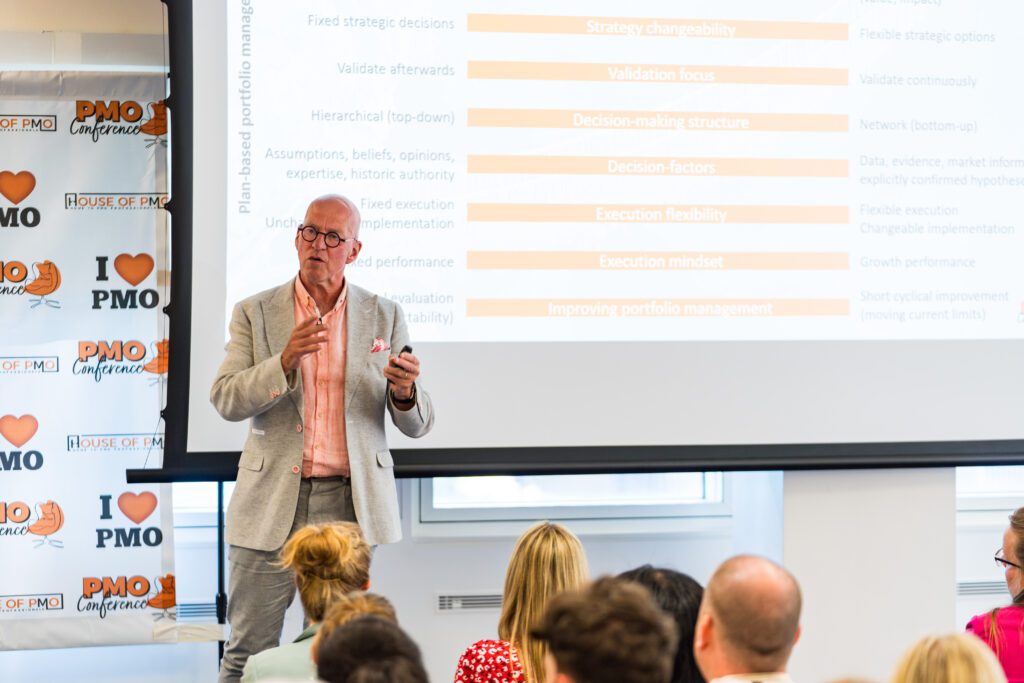Watch back all our PMO Conference sessions
Agile Portfolio Management – From Plan-Based to Discovery-Based
 Many organisations have set up portfolio management to manage the totality of portfolios, programmes and projects. As agile working methods are increasingly used in practice, governance via programmes, projects, budgets and resources is shifting to governance via roadmaps, backlogs, sprints and teams. This calls for agile portfolio management.
Many organisations have set up portfolio management to manage the totality of portfolios, programmes and projects. As agile working methods are increasingly used in practice, governance via programmes, projects, budgets and resources is shifting to governance via roadmaps, backlogs, sprints and teams. This calls for agile portfolio management.
Agile portfolio management is considered in full breadth in this session, from fully planned to complete discovery. Henny Portman covers ten focus areas to increase the agility of portfolio management as also described in the book Agile Portfolio Management – The Bridge to Strategic Agility (Henny Portman & Rini van Solingen).
Moving step by step towards more discovery-based portfolio management helps to make strategic choices in the portfolio better, earlier, and more flexibly. For each measure, Henny links it to the most critical control variable (E.g. cycle-time, work-in-progress, result orientation, validation focus, decision-making structure, …) on a scale from plan-based portfolio management to discovery-based portfolio management and discusses related techniques and examples.
Conference Session
Conference Deck
Download the conference deck
Insights from the Session
Written by Graham Gunn, PMO Conference Reporter
 This was a very well-presented analysis of the distinctions between the conventional approach to portfolio management (based on fixed or inflexible time frames, outputs, resources, goals, etc.), to a more agile approach which accepts the fact that internal and/or external conditions can change rapidly, and that the organisation may need to re-examine its strategy in a timely manner, with a focus on validation and generating value at each stage.
This was a very well-presented analysis of the distinctions between the conventional approach to portfolio management (based on fixed or inflexible time frames, outputs, resources, goals, etc.), to a more agile approach which accepts the fact that internal and/or external conditions can change rapidly, and that the organisation may need to re-examine its strategy in a timely manner, with a focus on validation and generating value at each stage.
The term “discovery-based portfolio management” is a recognition of the increasing volatility in the environments in which we attempt to run ever more complex projects – so when we start out, we can never be quite sure of what obstacles will show up, or what new opportunities will arise. To me, the idea of “discovery” also implies maintaining a sharp awareness of what is happening in and around the portfolio and being creative and flexible in finding ways (whether through management methods, technology, design, operational, etc.) to adapt the goals or ambitions accordingly.
It is pointed out that both conventional plan-based and agile management approaches, have their respective places in the wide spectrum projects we create, but, depending on the project and other circumstances, a mix of methods can be of optimum benefit. Henny’s book (on which the presentation is based) is called “Agile Portfolio Management – A Bridge to Strategic Agility”, and the slides neatly reinforce this idea by having in the background, various real bridges from around the world.
The core theme of the presentation identifies ten measures or control variables by which to compare the features of plan-based and agile portfolio management. These are shown in the slide below, in which the ten measures are drawn down the centre, and the approaches to each are described on either side – plan-based on the left and agile-based on the right.
The presentation slides following this one, delve into the detail of each measure, clarifying the various factors and giving examples where appropriate.
There were lots of enlightening ideas presented, and from my perspective, the most significant are summarised below:
- Continuous management improvement – lots of small, frequent changes can be more effective than a big change following an annual review for .
- Be prepared at any point to change what is being managed/produced to suit new conditions/markets/needs/…
- Build-in reverse ability – meaning that a pathway to a previous position is maintained if an experimental change does not provide the expected value.
- Decisions should be based on data or confirmed hypotheses rather than solely on assumptions, beliefs, opinions and history.
- For optimum flexibility and efficiency, the management structure should include networks of focused, accountable teams rather than a purely hierarchical, centralised organisation.
- Keep strategic options open, and validate the selected pathway frequently and from early on in the project.
- Manage by outcome (value, impact) rather than just output (product, service)
The next step for me based on this session, I will be buying the book!
From Tayo Richards, PMO Conference Reporter



